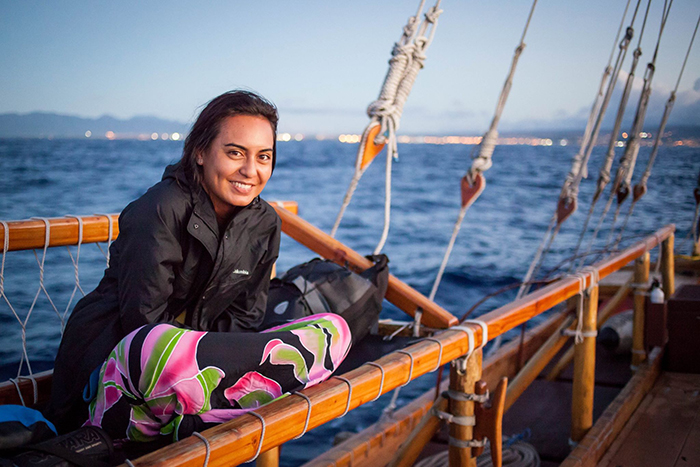After my first trip to New York in sixth grade, I told my parents I was going to college on the East Coast. My plan was to go to a place completely different than my own, to gain a new way of looking at the world. People would ask why a Hawaiian, Okinawan, Portuguese, Filipino, Scottish girl from Hawaii would ever leave paradise, but I loved every part of being away, especially the opportunity to intern at the Center for Folklife and Cultural Heritage. It made me appreciate parts of home that I often took for granted.
Through Emerson College’s D.C. internship program, I got to participate in the 2013 Smithsonian Folklife Festival’s One World, Many Voices: Endangered Languages and Cultural Heritage. This program brought cultural experts from all around the world to show how language is crucial to every culture’s survival. The curators selected fourteen communities, including a delegation from Hawaii to share the story of kuu olelo makuahine—my mother tongue, Hawaiian language.
The group included my uncle Earl Kawaa, a taro farmer and manaleo (native speaker); Lolena Nicholas, my Hawaiian language immersion preschool teacher; and Snowbird Bento, my kumu hula (hula teacher) who was recently asked to welcome the return of chief Kalaniʻōpuʻu’s mahiole (feather helmet) and ʻahu ʻula (feather cape) to Hawaii after 237 years (learn more).
I was fortunate to be with my mentors while also meeting different leaders in the Hawaiian community who continue to contribute to the well-being of Hawaiian language and culture with their work and the way they live their lives. Hearing interviews and conversations that highlighted language was inspiring, exposing me to ideas I never even thought to consider before.


I loved being at the Festival, but what I remember most is all the participants hanging out at the end of the day: late-night kanikapila jams, trying out new instruments, participating in dances from other cultures, or just walking to a store at midnight for ice cream. It was an exciting environment to learn and collaborate with others. Within two weeks I felt like I belonged to a family from Colombia even though we could only converse through a translation app on my phone. I found my Siletz aunties, my Garifuna uncles, my Hungarian sisters, and my Passamaquoddy, Tuvan, and Penobscot brothers. We didn’t share a mother language but a passion for our cultures.
After being away from Hawaii for three years, I returned home and followed my passion of instilling the importance of culture and language into the next generation. I worked as a Hawaiian culture teacher in an elementary school. Now I work at Kanehunamoku Voyaging Academy, a nonprofit organization that teaches STEM through traditional beliefs and perspective of a waa (canoe), inspiring students to explore careers in the maritime industry. The academy was founded based on the teachings of Micronesian master navigator Papa Mau Pialug, who believed children should begin learning how to navigate at a young age and who brought his skills across the Pacific to reteach traditional navigation to Hawaiians.
I get to work on a farm, sail on a double-hull canoe, and teach kids about Hawaiian culture. The ocean is my classroom, a place of learning not only for my students but also for myself. Language and culture, work, play—every aspect of my life has molded into one. It’s a privilege to have found this kind of career early in my life.

Currently, I am working on my education graduate degree in curriculum studies at the University of Hawaii at Manoa. We’re the first STEM2 cohort, adding social sciences and sense of place to the standard science, technology, engineering, and mathematics. In my graduate research, I connect my lessons to the Mālama Honua Worldwide Voyage.
On this multiyear journey, two Hawaiian voyaging canoes, Hōkūleʻa and Hikianalia, are sailing around the world while the crew uses the stars and the environment to navigate. Hōkūleʻa will visit the East Coast of the United States in 2016, and I hope you get to meet her. She is an incredible canoe that inspired the revitalization of Hawaiian culture and traditional navigation not only in Hawaii but all of Polynesia.
The canoes carry a message of mālama honua (taking care of our Earth). I hope the lessons I create will show students around the world that we can help care for the Earth by celebrating the similarities between its many peoples and places. Just like the Folklife Festival, this journey—for the canoes and for me—is a reminder of the importance of diversity in culture and language.
Kaʻai McAfee-Torco interned at the Center for Folklife and Cultural Heritage with Marjorie Hunt and Arlene Reiniger in 2012 and was a presenter at the 2013 Smithsonian Folklife Festival. She is a communication studies graduate from Emerson College and plans to receive her education graduate degree in curriculum studies at the University of Hawaii at Manoa this summer. She is currently a teacher and curriculum developer at Kanehunamoku Voyaging Academy.


